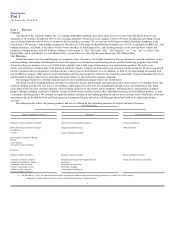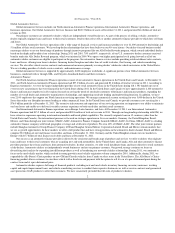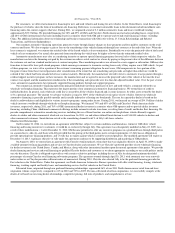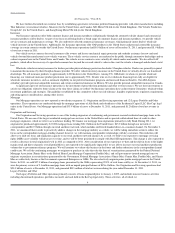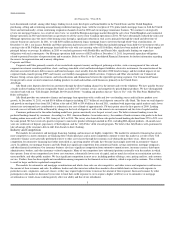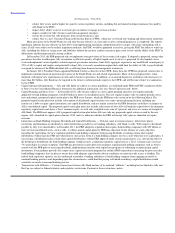Ally Bank 2011 Annual Report Download - page 10
Download and view the complete annual report
Please find page 10 of the 2011 Ally Bank annual report below. You can navigate through the pages in the report by either clicking on the pages listed below, or by using the keyword search tool below to find specific information within the annual report.
Table of Contents
Ally Financial Inc. • Form 10−K
• subject Ally to new and/or higher fees paid to various regulatory entities, including but not limited to deposit insurance fees paid by
Ally Bank to the FDIC;
• impact Ally's ability to invest in certain types of entities or engage in certain activities;
• impact a number of Ally's business and risk management strategies;
• restrict the revenue that Ally generates from certain businesses; and
• subject Ally to a new Consumer Financial Protection Bureau (CFPB), which has very broad rule−making and enforcement authorities.
Many provisions of the Dodd−Frank Act will only become effective at a later date or after a rulemaking process is completed. The orderly
liquidation authority became effective in July 2010, with implementing regulations adopted thereafter in stages, with some rulemakings still to
come. If Ally were subject to the orderly liquidation authority, the FDIC would be appointed as receiver, giving the FDIC the ability to wind−up
Ally, including the ability to assign assets and liabilities without the need for creditor consent or prior court review and the ability of the FDIC to
differentiate and determine priority among creditors.
In December 2011, the FRB proposed rules to implement some provisions of the systemic risk regime. If adopted as proposed, among other
provisions, the rules would require Ally to maintain a sufficient quantity of highly liquid assets to survive a projected 30−day liquidity stress
event and implement various liquidity−related corporate governance measures; limit Ally's aggregate exposure to any unaffiliated counterparty to
25% of Ally's capital and surplus; and potentially subject Ally to an early remediation regime that could limit the ability of Ally to pay dividends
or expand its business if the FRB identified Ally as suffering from financial or management weaknesses.
In January 2012, President Obama appointed Richard Cordray as director of the CFPB. Since then, the CFPB has proposed various rules to
implement consumer financial protection provisions of the Dodd−Frank Act and related requirements. Many of these proposed rules, when
finalized, will impose new requirements on Ally and its business operations. In addition, as an insured depository institution with total assets of
more than $10 billion, Ally Bank may be required in the future to submit periodic reports to the CFPB, and will become subject to examination
by the CFPB.
• Capital Adequacy Requirements — Ally and Ally Bank are subject to various guidelines as established under FRB and FDIC regulations. Refer
to Note 23 to the Consolidated Financial Statements for additional information. See also “Basel Capital Accord” below.
• Capital Planning and Stress Tests — In December 2011, Ally became subject to a new capital planning and stress test regime generally
applicable to bank holding companies with $50 billion or more of consolidated assets. The new regime requires Ally to conduct periodic stress
tests and submit a proposed capital action plan to the FRB every January, which the FRB must take action on by the following March. The
proposed capital action plan must include a description of all planned capital actions over a nine−quarter planning horizon, including any
issuance of a debt or equity capital instrument, any capital distribution, and any similar action that the FRB determines could have an impact on
Ally's consolidated capital. The proposed capital action plan must also include a discussion of how Ally will maintain capital above the minimum
regulatory capital ratios and above a Tier 1 common equity−to−total risk−weighted assets ratio of 5 percent, and serve as a source of strength to
Ally Bank. The FRB must approve Ally's proposed capital action plan before Ally may take any proposed capital action covered by the new
regime. Ally submitted its capital plan in January 2012, and it is unknown whether the FRB will accept Ally's plan as submitted or require
revisions.
• Limitations on Bank Holding Company Dividends and Capital Distributions — Utah law (and, in certain instances, federal law) places
restrictions and limitations on dividends or other distributions payable by our banking subsidiary, Ally Bank, to Ally. With respect to dividends
payable by Ally to its shareholders, in December 2011, the FRB adopted a regulation that requires bank holding companies with $50 billion or
more in total consolidated assets, such as Ally, to submit annual capital plans for FRB non−objection. In the absence of a non−objection
regarding the capital plan, the new regulation prohibits bank holding companies from paying dividends or making certain other capital
distributions without specific FRB non−objection for such action. Even if a bank holding company receives a non−objection to its capital plan, it
may not pay a dividend or make certain other capital distributions without FRB approval under certain circumstances (e.g., after giving effect to
the dividend or distribution, the bank holding company would not meet a minimum regulatory capital ratio or a Tier 1 common ratio of at least
5%) and subject to certain exceptions. The FRB has previously issued supervisory guidance requiring bank holding companies such as Ally to
consult with the FRB prior to increasing dividends, implementing common stock repurchase programs or redeeming or repurchasing capital
instruments. Such guidance provides for a supervisory capital assessment program that outlines FRB expectations concerning the processes that
bank holding companies have in place to ensure they hold adequate capital under adverse conditions to maintain ready access to funding. The
federal bank regulatory agencies are also authorized to prohibit a banking subsidiary or bank holding company from engaging in unsafe or
unsound banking practices and, depending upon the circumstances, could find that paying a dividend or making a capital distribution would
constitute an unsafe or unsound banking practice.
• Transactions with Affiliates — Certain transactions between Ally Bank and any of its nonbank “affiliates,” including but not limited to Ally and
ResCap, are subject to federal statutory and regulatory restrictions. Pursuant to these restrictions, unless
7




